One of the best things about Linux is its access to all the different Linux distributions – commonly known as Linux distros. Each distro holds a unique philosophy and thereby bundles in different software and utilities, making it perfect for certain users but not all.
So what’s the best Linux distro for students?
Well, there aren’t many specific distributions curated with student usage in mind. However, depending on what students most want and need from their computers, we have put together a list of the best Linux distros.
What to look for in a Linux distro meant for students?
Before we dive into the top 10 Linux distros for students, here’s a quick look at the different factors we referred to while selecting the distros. This might help if you want to do some solo-searching for the best distro for students.
Optimized for Laptops
Students are always going to prefer laptops over desktops. This is primarily because laptops are far more portable and compact, which is crucial for keeping up with the student lifestyle.
A proper desktop takes up too much space, which the student might not have in his/her room, especially if they are a college-goer and living in a dorm. Furthermore, you can’t carry your desktop to school or college, which is necessary for taking notes and sometimes even engaging in classwork.
As such, our very first focus was on making sure all the distros we recommend are optimized for running on Laptops.
Access to a wide variety of tools and utilities
Depending on the distro you are using, you will have access to different software repositories.
For example, if you are on an Arch-based distro, you will most likely have access to the Arch package repository and the Arch user repository (AUR), which contains around 60,000 packages combined. In contrast, users of a Debian-based distro will have access to the Debian repository, which contains around 70,000 packages.
That being said, these numbers don’t mean too much. You should note that almost all Linux distros will be compatible with the major apps like LibreOffice, Firefox, VLC, GIMP, VS Code, and the lot. If you plan on using mostly mainstream applications, then almost any distro will cut it. The difference in the package count only reflects access to some very niche binaries and source packages.
Now the main thing you should be concerned about here is access to the latest up-to-date software. And in this regard, the distros and their repos do matter.
For example, Debian focuses on stability, and the apps on their repos are thoroughly tested before they are made available. This means that if a new version of the software you are using is released, it will most likely take a few months before it shows up on the repo. However, in the case of Arch or Fedora, since they are rolling release distros, you will get access to all the latest and greatest software asap.
For this read, we made sure to include distros that give you access to a lot of packages and frequent updates. Granted, some distros focus more on stability while others focus on being bleeding edge. As such, you also get options to choose a distro based on your preference.
Suitable for multitasking
Although multitasking isn’t advisable for human productivity, having a system that can multitask is definitely useful.
We all know that the cornerstone of getting any research done has the ability to switch between a browser window and your note-taking app seamlessly. And let’s not forget the importance of having a “concentration music for focused work” playlist in the background. Having an active chat window is also helpful for talking with friends and sharing notes.
However, having so many windows and apps opened simultaneously will make the desktop extremely cluttered and unmanageable. We made sure to include a couple of distros that can help you with window management and let you create virtual desktops or workspaces for your different apps.
Helpful and active community
The community surrounding your Linux distro is as important as the distro itself. While using a particular Linux distro, you will eventually run into some issues. When that happens, you can’t call a support center because Linux has none. Instead, you will need to head on over to the community forum and discuss your issue with the other, more experienced members.

Now by having access to an active and helpful community, you can rest assured that your problems will get addressed and resolved considerably quickly. And not just that, but through communities and forums, you can also get to make new friends, discover software that other people use, and learn more about better using your operating system.
The Top 10 Linux Distros for Students
#1. Ubuntu

Ubuntu
Ubuntu is one of the most popular Linux distros out there and also the one that gets the most recommended to new users. It prioritizes ease of use and making things as beginner-friendly as possible. As such, people coming over from Windows/Mac, or users who are new to computers in general, will find Ubuntu extremely welcoming.
Furthermore, most online guides and tutorials you come across will offer instructions curated for the Ubuntu system because of its massive popularity. As such, going with Ubuntu makes things super simple for new Linux users who don’t yet know how to translate instructions meant for one distro to another.
Likewise, software vendors also consider releasing their apps in the .deb format supported by Ubuntu and other Debian-based distros. Also, proprietary software that makes its way into Linux will most likely make it available for Ubuntu first. This gives Ubuntu users access to a wide range of apps and packages.
And coming to the community, Ubuntu has two main forums – Ask Ubuntu and Ubuntu Forums. If and when you run into a problem or have a question, you can drop it here, and you are almost certain to get a solution in a couple of hours. The community is super active and quite helpful. You will also find extensive documentation for Ubuntu giving you detailed step-by-step instructions to get started and eventually master your Ubuntu system.
Despite its massive popularity, it is worth noting that Ubuntu strays away from some core open-source philosophies. For example, Canonical – Ubuntu’s parent company, tends to collect user data (opt-in) and also pushes the Snap Store (Ubuntu’s proprietary package manager) on new users. Furthermore, Ubuntu is slightly more bloated than other Linux distros, which does affect the system performance.
Ubuntu Pros:
- Extremely popular
- Beginner-friendly
- Access to tons of binaries and source packages
- Detailed documentation with helpful how-tos and guides
- Active and Helpful communities and forum
Ubuntu Cons:
- Bloated
- Collects user data (user has the option to opt-in or out)
- Pushes Snap apps
#2. Linux Mint
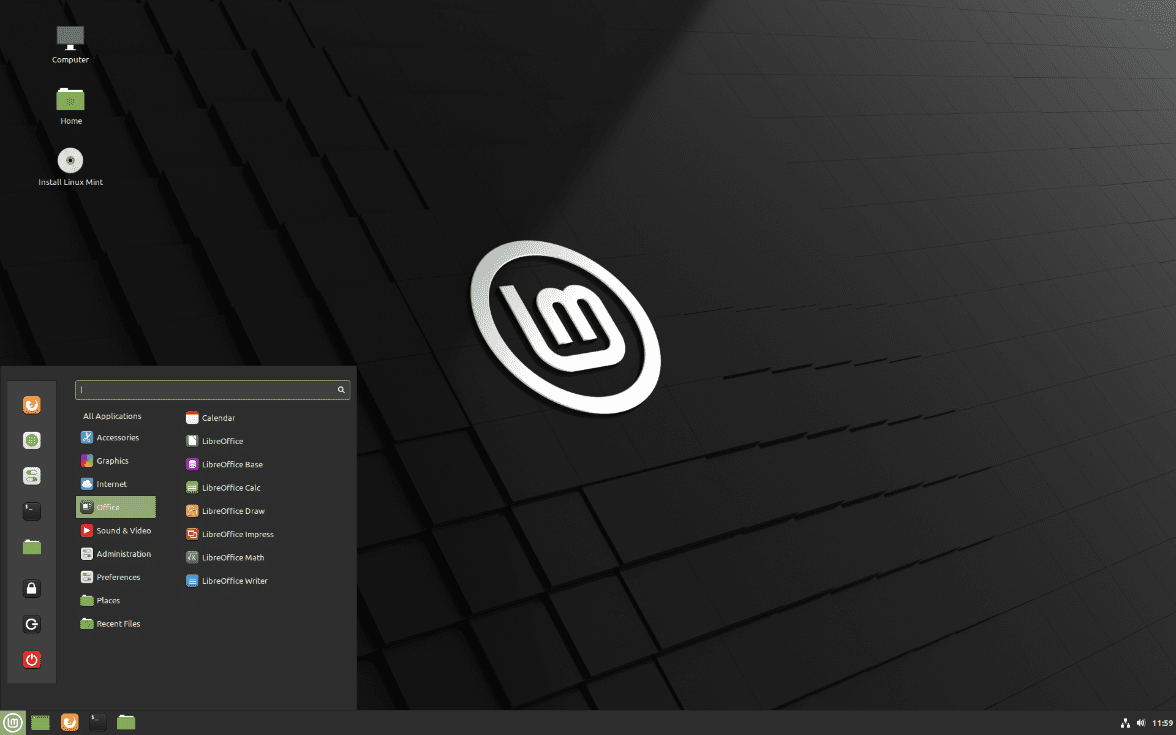
Linux Mint
Linux Mint is an Ubuntu-based distro primarily targeted at users who are migrating from Windows to Linux. But with that being said, its focus on stability, reliability, and ease of use makes it perfect for a student who wants an OS that works right out of the box.
Since Linux Mint is based on Ubuntu, it benefits from many of Ubuntu’s perks. However, the Linux Mint developers have worked to put in the extra effort to mitigate many of the cons we cited for Ubuntu.
For example, every guide, tutorial, and how-to available for Ubuntu will seamlessly translate (almost) to Linux Mint. This also holds for software availability. Almost every software that works on Ubuntu will work on Linux Mint, only barring a few that require specific system libraries unique to Ubuntu.
However, unlike Ubuntu, Linux Mint has no corporate agenda. It is a completely community-driven project where the user is the central priority. They don’t track or collect user data and also don’t push users to use Snap apps. In fact, Snap Store doesn’t even come with the distro and needs to be downloaded/installed manually.
Furthermore, Linux Mint offers users the option to choose between two Windows-like desktop environments – Cinnamon and Mate. Both of them are far lighter than Ubuntu’s offering, which means Linux Mint will demonstrate better performance.
It’s also worth noting that Linux Mint is based on the Ubuntu LTS releases and not on the non-LTS releases. When Ubuntu releases newer non-LTS versions, Linux Mint will not directly incorporate those features into its build. This also means that the Linux Mint development cycle lags behind that of Ubuntu.
Now, in terms of help and support, you will also have access to their large and active community and forum to help you solve any issue you may encounter. Their documentation is also thorough, offering sufficient help to new users to get started.
Linux Mint Pros:
- Ideal for Windows users migrating to Linux
- Very stable and reliable
- Ubuntu-based. Almost all Ubuntu compatible software also run here
- Community-driven project
- Option to choose between three different desktop environments
Linux Mint Cons:
- Linux Mint release cycle is slower than that of Ubuntu
Read: Linux Mint vs. Ubuntu – Which Is Best For You?
#3. Elementary OS

Elementary OS
Like Linux Mint, Elementary OS is another Ubuntu-based distro targeted at new Linux users, but this caters to Apple users. You will get an extremely user-friendly desktop environment called Pantheon that takes inspiration from MacOS.
Unlike most distros and desktop environments that focus on making things as customizable as possible, Elementary OS and Pantheon take the opposite route. This is great for new users who don’t want to get overwhelmed with tons of options. Furthermore, it also makes the distro much more lightweight.
Moving on, as it’s Ubuntu-based, you get support for almost all Ubuntu compatible apps. Similarly, almost all the Ubuntu guides and tutorials will also work here as well.
Also, similar to Linux Mint, Elementary OS is based on Ubuntu’s LTS release. But that being said, you should note that Elementary OS is way behind Ubuntu’s development cycle. Its latest version – Elementary OS 5.1.7 Hera, is based on Ubuntu 18.04 LTS (current is Ubuntu 21.04). As such, the packages available for Elementary OS are fairly old, which can be an issue for some users.
However, if you don’t mind sourcing your packages and software from other repositories and package managers, then Elementary OS offers a solid, stable, and reliable base by going with an older distro version.
Elementary OS Pros:
- Intuitive and user-friendly interface. Ideal for Mac users migrating to Linux
- Ubuntu-based. Inherits all Ubuntu benefits
- It comes bundled with tons of useful and necessary apps out of the box
- AppCenter allows you to download both free and paid apps
- Stable and reliable
- Secure and privacy-respecting
Elementary OS Cons:
- Not very customizable
- Lags behind Ubuntu’s development cycle
#4. Pop!_OS
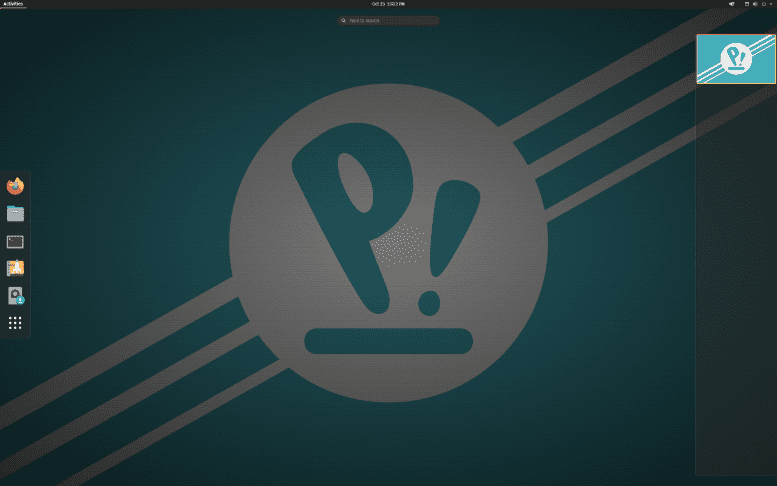
POP!_OS
Pop!_OS is yet another Ubuntu-based distro with a focus on professionals and students. A visit to their official website clearly shows you that the distro is catered towards Deep Learning, Engineering, Media Production, and even Bioinformatics. As such, if you are a student in any of these fields, then Pop!_OS will prove to be an ideal Linux distro for your needs.
With that being said, you shouldn’t mistake Pop!_OS for being unintuitive. In fact, it is one of the most minimalist distros out there.
It doesn’t care about morphing its looks and aesthetics to please users coming from Mac or Windows. Instead, it uses the same desktop environment as Ubuntu, but a much more decluttered one, with everything available right within reach. It might take you a few days to get accustomed to Pop!-OS, but once you do, your productivity level will skyrocket.
Moving on, just like all other Ubuntu-based distros, almost all Ubuntu compatible software will also run on Pop!_OS. Furthermore, the Pop!_OS team is much more in pace with the Ubuntu development cycle. Pop!_OS releases are just 1 or 2 months off Ubuntu releases. Furthermore, there’s a POP!_OS LTS and non-LTS version corresponding to Ubuntu LTS and non-LTS.
Pop!_Planet is currently under development, but it’s a great place to connect with other users of the distro. Whereas, if you want help in learning the system basics, you can check out their official support page, which lets you submit a support ticket and access their detailed documentation.
Pop!_OS Pros:
- Optimized for modern hardware with a separate Nvidia version
- Super simple and minimal
- Ubuntu-based. Inherits all Ubuntu perks
- Catered towards professional usage in STEM fields and Media Production
Pop!_OS Cons:
- Slightly unintuitive and will take a few days to learn
- 64-bit only
#5. Manjaro
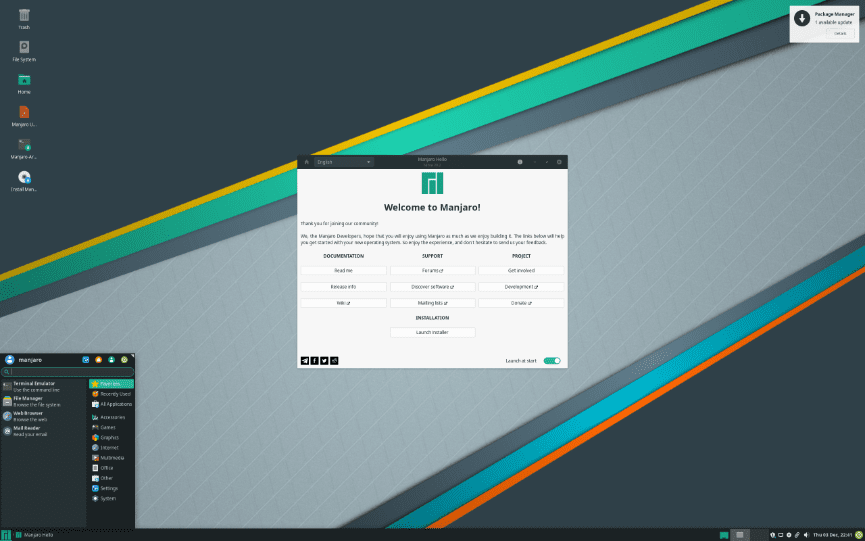
Manjaro
Finally, straying away from all the Ubuntu-based distros, we have Manjaro, an Arch-based Linux distribution. Now Arch has a reputation for being extremely powerful and equally complicated. As such, it’s rarely recommended to new Linux users. However, Manjaro manages to take all the powerful features of Arch and make it available in a user-friendly package.
One of the main beauty of using Arch is that it’s a rolling release distro. This basically means that users get access to frequent software updates almost as soon as they are released. Not just that, but Arch users have access to the AUR (Arch User Repository), which is home to tens of thousands of packages.
Now Manjaro takes these features and makes it super simple and accessible to new users. One of their most notable features is the use of Pamac – their excellent graphical package manager, which makes searching, installing, and updating software super simple. Not to mention Pamac also integrates with other repos so you can access everything under one roof.
This makes Manjaro the perfect distro for students who like to play around with different apps and discover new software. The distro is also insanely customizable and supports almost all the popular Linux desktop environments like Gnome, KDE, XFCE, Cinnamon, Mate, and many more.
Another thing worth noting is that Manjaro is a community-based project and likes to keep its users at the center of attention. They have an active forum and excellent documentation to help new users with all their questions and issues.
Manjaro Pros:
- Based on Arch Linux
- Access to AUR
- Up to date and access to new software
- Uses the excellent Pamac GUI package manager
- Supports tons of different desktop environments
- Active and Friendly Community
Manjaro Cons:
- It can appear somewhat bloated. (this is why they have a minimal installation available)
- Manjaro repo is a bit slow at syncing with Arch repo
#6. Fedora

Fedora
The Fedora Linux distribution primarily caters to developers. As such, it isn’t ideal for non-tech-savvy students. But on the flip side, it is one of the most recommended distros for students in Computer Science.
You see, Fedora is based on RHEL (Red Hat Enterprise Linux), or rather RHEL is based on Fedora. Fedora is actually upstream to RHEL, meaning all RHEL features are first tested on Fedora and then passed onto RHEL. This clearly makes Fedora the perfect distro to work with if you plan on working for/with RHEL software. It is also the distro of choice for students seeking RHEL certifications.
Other than this, Fedora is also great if you like staying on the bleeding edge of new technology. The distro gets access to new software as soon as they are released.
But with that being said, it is worth pointing out that Fedora focuses on Open-source software only. Closed-source and proprietary software, including drivers, is unsupported. This means Fedora is a no-go if your laptop is running an Nvidia GPU.
In terms of usability, Fedora uses a vanilla Gnome desktop environment which is simple and easy to use. However, there aren’t many GUI tools onboard, and you will have to use the command line for most activities.
Now, if you run into any problems, Fedora is blessed with an active community, a helpful forum, and rich documentation to resolve all your questions and issues.
Fedora Pros:
- Backed by RHEL
- Stable and secure
- Bleeding edge distro – access to the latest software as soon as they are available
- Good integration with Snap and Flatpak – additional software repositories
- It comes with vanilla Gnome
- Used by Linus Torvalds
Fedora Cons:
- No Support for Proprietary and/or closed source software
- A bit difficult for non-tech-savvy users
- It doesn’t support 32-bit systems
#7. OpenSUSE
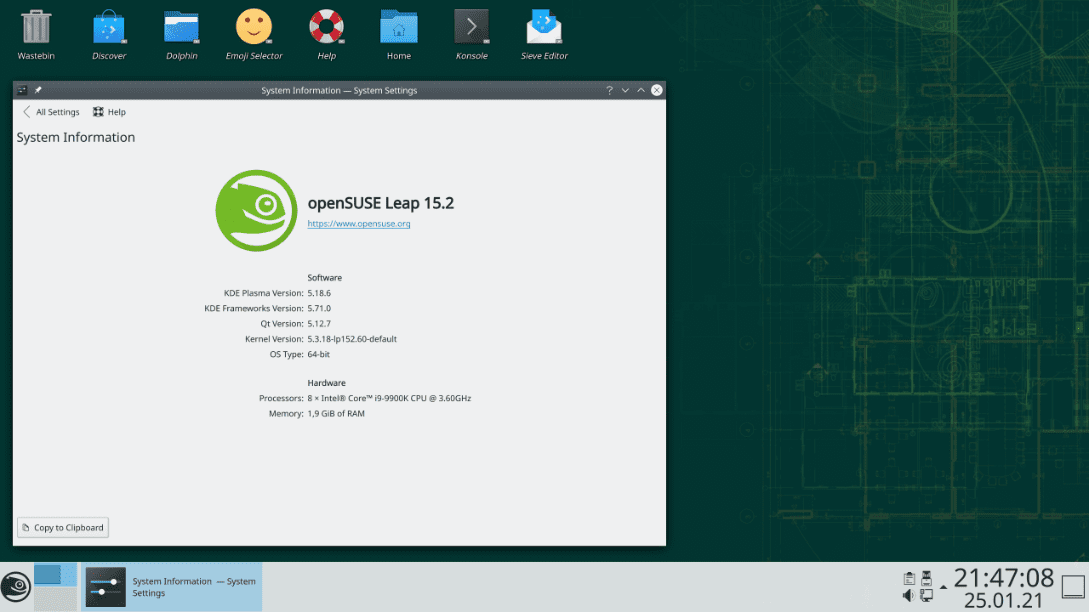
OpenSUSE
Similar to Fedora, OpenSUSE is also directed towards developers – sysadmins and website owners in general. With OpenSUSE, you get access to a robust and stable platform.
You get access to tons of useful tools to help you develop, deploy, and maintain your apps and websites. This also includes YaST, which is by far one of the most comprehensive Linux system configuration and installation tools available right now.
Students studying web development or interested in the cloud will surely find OpenSUSE a fantastic Linux distribution to try out.
What’s more, depending on your needs, OpenSUSE gives you the option to choose between a rolling release version – Tumbleweed with quick access to newer software, and a regular release version – Leap with a focus on stability and reliability. It is also highly configurable and gives you the option to choose between various desktop environments, including Gnome and KDE.
The distro is also blessed with an active community and has excellent documentation to help you start with the OS.
OpenSUSE Pros:
- Extremely stable and reliable
- Comes with YaST – the most powerful and comprehensive Linux setup tool
- Easily install packages from other sources
- Built-in drivers
- Supports multiple desktop environments
- Flexibility to choose between a rolling release or regular release
OpenSUSE Cons:
- Uses an Old Kernel
- Complex permission policy
#8. Kali Linux
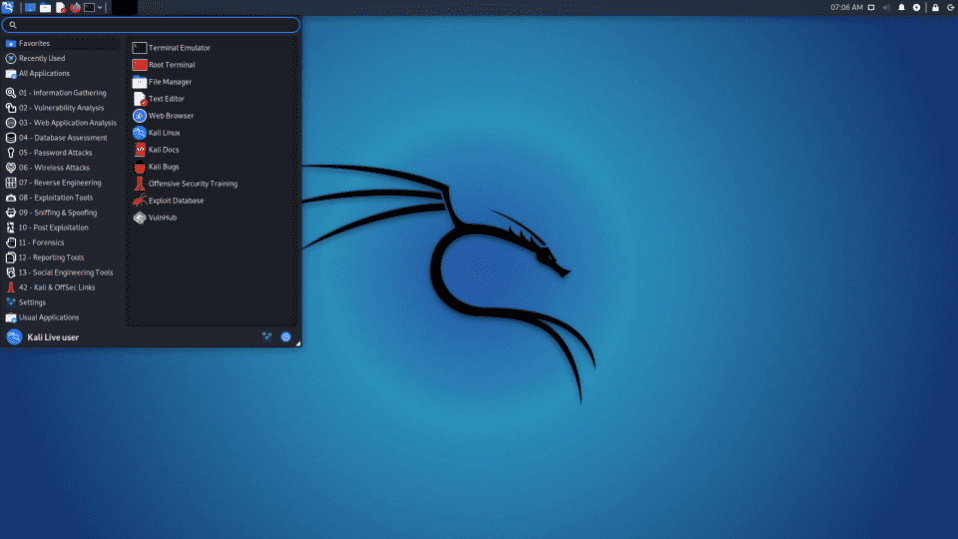
Kali Linux
Kali Linux is a well-known specialized Linux distro for ethical hacking. It is even the distro of choice for some universities that teach cybersecurity. Now there are a lot of reasons why Kali Linux has developed this revered status.
However, one of the main reasons is its seamless integration with many security tools right out of the box. It is also compatible with cheap and low-powered devices, which is a godsend for students low on cash.
With Kali Linux, you will get your hands on over 600 security tools for penetration testing, security research, computer forensics, and even reverse engineering. You will also have access to meta-packages to help streamline your workflow.
Other than this, there are different Kali Linux flavors like an Undercover Mode that disguises the distro with a Windows skin to avoid suspicion and Kali NetHunter, which is basically Kali Linux for Android devices. The distro is also available with different desktop environments like Xfce, Gnome, and KDE.
Now, Kali Linux is based on Debian (the same distro Ubuntu is based on) and is developed from the popular but discontinued BackTrack distro. As such, Kali Linux benefits from having the massive community connected to BackTrack migrated over to its side. They also provide extremely rich documentation to help you get started and learn the ins and outs of the OS.
Kali Linux Pros:
- Stable, reliable, and secure
- Debian-based. Access to the large Debian repo
- Tons of tools to help you with penetration testing, security research, computer forensics, and reverse engineering
- Supports different desktop environments
Kali Linux Cons:
- Not very useful for general work
#8. Raspbian/Raspberry Pi OS
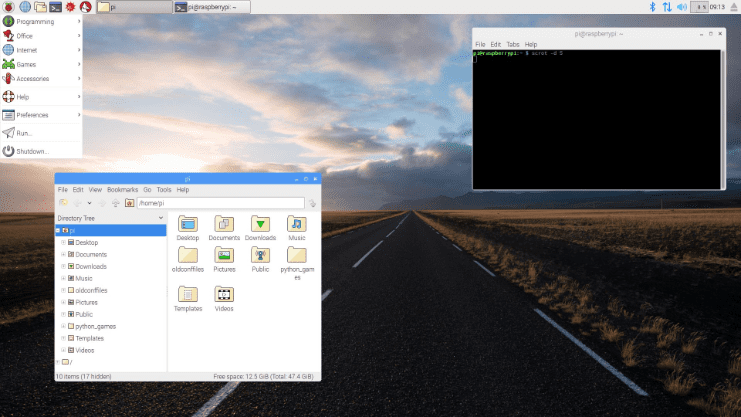
Rasbian
This is a fun one! Raspbian, currently known as Raspberry Pi OS, is the official operating system for Raspberry Pi.
Now in case you don’t know, a Raspberry Pi is an affordable, credit card-sized computer capable of doing everything you’d expect from a traditional desktop PC. It’s the perfect system for doing cool projects to help you learn computers and coding.
Now, the Raspberry Pi supports tons of different OSes, but their official OS is the Raspberry Pi OS based on Debian. It comes bundled with tons of awesome tools and packages like Python, Mathematica, Greenfoot, BlueJ, Node-RED, and tons more, all of which are perfect for students learning how to code and creating amazing projects.
They also have a very active and enthusiastic community and forum, not to mention rich documentation to help you get the most of the system.
Raspbian Pros:
- Based on Debian
- Stable and reliable
- It comes with tons of tools and programs for doing small to large projects and learning to code.
- Built-in app store
- Super easy to install
- Tons of project ideas available online
Raspbian Cons:
- Fundamental and antiquated looking UI
- Optimized for Raspberry Pi devices. Users might face issues trying it on standard hardware
#10. Vanilla Arch
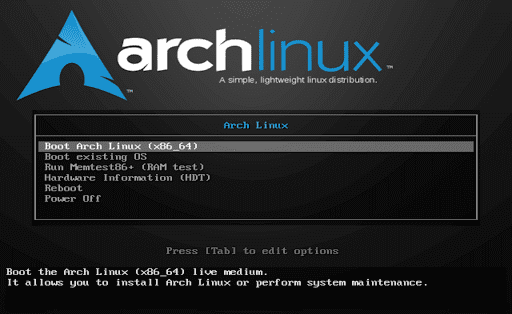
Arch Linux
Now for the final entry in our list of the best Linux distros for Students, we have Arch Linux – the most powerful Linux distro, as well as the most daunting.
Now the reputation of Arch being too complicated stems from the fact that it’s a barebone distro that gives you nothing more than some core files and packages. You don’t even get a GUI. The distro installation needs to be done via the command line.
This can be scary for new users. However, it also gives you full control over what you want (and don’t want) to run on your system.
You are in full control over what goes into your system, allowing you to create a truly “personal” computer. You can install whatever desktop environment you want, and on top of that, you have access to the AUR, which, like we previously stated, has access to tens of thousands of binaries and source packages.
Furthermore, by using Arch, you are forced to learn about the nitty-gritty of an operating system which is great for computer science students, especially those who are learning Linux. Following this point, the Arch Wiki is one of the most valuable resources on Linux – where even other distros link to it. And in case you are a newbie, the Arch Forum is the perfect place to discuss all your doubts and questions.
Arch Linux Pros:
- A cutting edge rolling release distro with access to the latest software asap
- Extremely minimal with no bloat
- Complete control over everything
- Access to the huge AUR
- Excellent hardware support
- Excellent documentation
Arch Linux Cons:
- Intimidating for new users
- No graphical installer
- Easy to break if you don’t know what you are doing
Wrapping Up
So this was our list of the top 10 Linux distros for students. We hope you found this list interesting, and it helped you find the right Linux distro to go along with your academic career.
As you can see, we made sure to include various distros to ensure there is something for every user.
Students from non-STEM fields can go for simpler and intuitive distros like Ubuntu, Linux Mint, and Elementary OS, focusing on stability and ease of use.
Students studying STEM can look at POP!_OS or even Manjaro as they provide access to tons of software and an up-to-date system.
Likewise, students studying development and the Cloud will find Fedora and OpenSUSE very instrumental to their workflow. At the same time, Raspbian will prove to be an excellent OS for students learning how to code.
Kali Linux is perfect if you are considering a career in cybersecurity and want to familiarize yourself with the tools professionals use.
And finally, we have Arch Linux, the perfect distro for students who consider themselves as power users and want to develop a better understanding of the ins and outs of Linux.

5 comments
PCLinuxOS should be on the list.
no debian… realy ?
debian should be number 1
Debian has changed a lot and is now more user friendly compared to Arch , fedora etc, i think it should be on the list.
EndlessOS